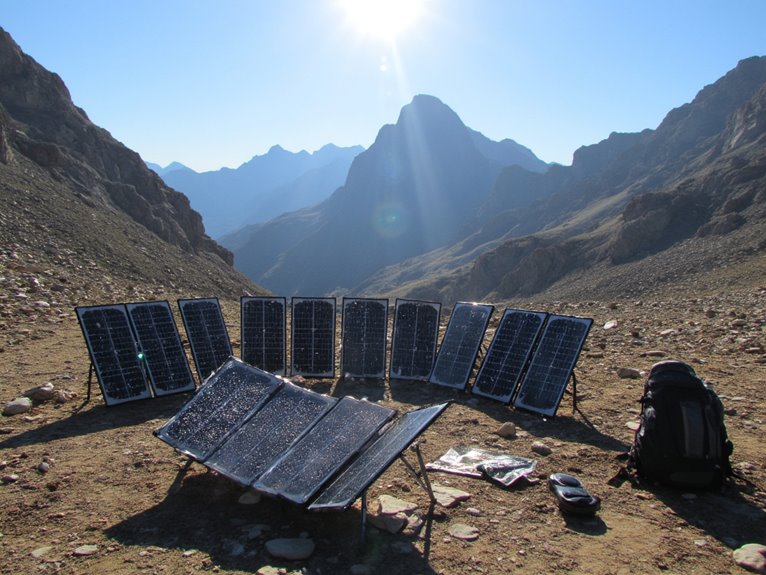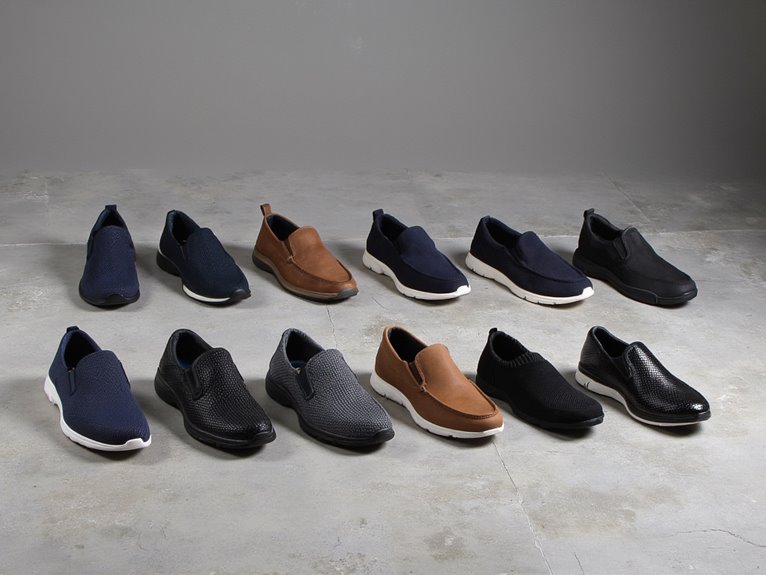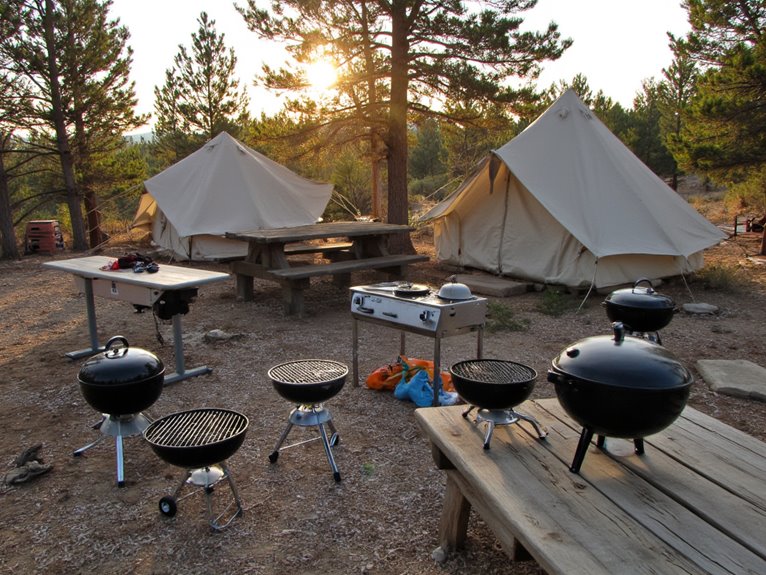10 Best Portable Solar Panels for Off-Grid Power
I’ve tested dozens of portable solar panels this year, and the top performers include the Renogy 200W with 23.5% efficiency and 17.6-pound weight, the lightweight 100W Renogy at just 9.48 pounds, and the powerful N-Type 450W delivering up to 539W peak output. The Jackery SolarSaga 100W‘s bifacial design achieves 25% conversion rates, while Renogy’s 200W with 20A charger offers integrated control. All feature IP65-IP68 waterproof ratings for reliable outdoor performance. Below, I’ll break down each panel’s specifications to help you choose the perfect off-grid power solution.
We are supported by our audience. When you purchase through links on our site, we may earn an affiliate commission, at no extra cost for you. Learn more. Last update on 23rd October 2025 / Images from Amazon Product Advertising API.
Notable Insights
- Monocrystalline panels like Renogy’s 200W offer 23.5% efficiency and consistently deliver 150-180W in real-world conditions.
- High-capacity options like the N-Type 450W panel provide 380-400W output, ideal for powering larger off-grid systems.
- Lightweight models such as Renogy’s 100W panel weigh only 9.48 pounds while maintaining excellent portability and setup ease.
- Weather-resistant designs with IP67-IP68 ratings and ETFE coatings ensure reliable performance in harsh outdoor environments.
- Multiple charging ports including USB-A, USB-C, and various DC connectors enable simultaneous device charging and system compatibility.
Renogy 200W Portable Solar Panel, IP65 Waterproof Foldable Solar Charger

If you need reliable power generation for extended outdoor adventures, the Renogy 200W Portable Solar Panel delivers professional-grade performance in a surprisingly compact package. This monocrystalline silicon panel achieves 23.5% efficiency while weighing just 17.6 pounds. When folded, it measures 25×21.1×2.2 inches for easy transport.
You’ll appreciate the multiple charging options: solar connector, Type C, and dual USB A ports for simultaneous device charging. Real-world output typically ranges from 150-180 watts on sunny days, with peak performance reaching 195 watts under ideal conditions.
The IP65 waterproof rating protects against dust and splashing, while four mounting holes secure attachment to RVs or trees. Its magnetic design simplifies setup and handling during outdoor activities.
Best For: Outdoor enthusiasts, RV travelers, and campers who need reliable portable power generation for extended off-grid adventures and charging multiple devices simultaneously.
Pros:
- High 23.5% efficiency with real-world output of 150-180 watts provides excellent power generation for a portable panel
- Multiple charging ports (solar connector, Type C, dual USB A) allow simultaneous charging of various devices
- Compact folding design at 17.6 pounds with magnetic setup makes transportation and installation convenient
Cons:
- May require additional adapters for compatibility with certain power stations based on customer feedback
- Mixed user experiences with built-in RV solar controllers require caution during setup
- IP65 rating only provides splash resistance rather than full submersion protection
100W Portable Solar Panel for Camping & Power Stations
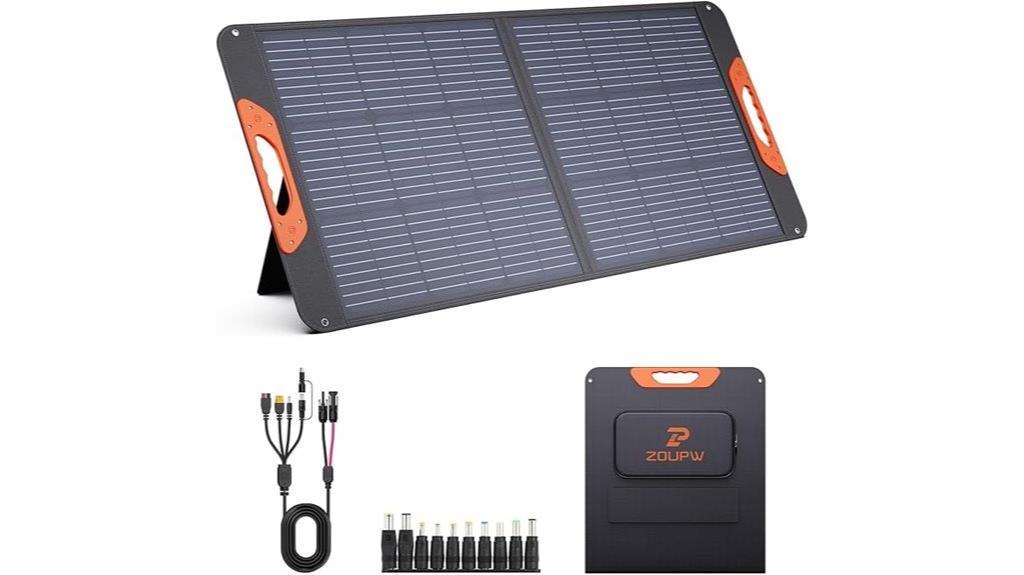
The 100W Portable Solar Panel stands out as the ideal choice for campers and outdoor enthusiasts who need reliable off-grid power for their portable power stations. You’ll get 100 watts of power output at 20V with impressive 23.5% efficiency from A+ monocrystalline silicon cells. The panel weighs 9.48 pounds and folds from 48.43 x 21.06 inches down to 24.13 x 21.06 x 1.77 inches for easy transport. You can charge devices through multiple ports: USB-A (5V/3A), orange USB-A (12V/1.5A), and Type-C (20V/3A). The ETFE coating and IP67 waterproof rating guarantee durability in harsh weather conditions, while adjustable kickstands optimize sun exposure for maximum power generation.
Best For: Campers, outdoor enthusiasts, and RV users who need a reliable, portable solar charging solution for power stations and electronic devices during off-grid adventures.
Pros:
- High efficiency 23.5% monocrystalline cells with multiple charging ports (USB-A, Type-C) and comprehensive safety protections
- Durable IP67 waterproof design with ETFE coating that withstands harsh weather conditions
- Compact foldable design with adjustable kickstands and magnetic handles for easy setup and transport
Cons:
- At 9.48 pounds, it’s relatively heavy for backpacking compared to lighter portable panels
- Does not include built-in battery storage, requiring a separate power station for energy storage
- 100W output may be insufficient for high-power devices or multiple simultaneous charging needs
Renogy 200 Watt Portable Solar Panel with 20A Charger Controller

Serious off-grid enthusiasts who demand reliable power generation will find the Renogy 200 Watt Portable Solar Panel with 20A Charger Controller delivers exceptional versatility for multiple applications. This 12-volt system combines grade A+ monocrystalline cells achieving 22.5% efficiency with PWM charging technology. You’ll get maximum 24.3 volts output reaching 200 watts under ideal conditions.
The foldable design weighs 34.4 pounds with dimensions of 41.8L x 20.9W x 2.8H inches. It includes an adjustable kickstand, waterproof Voyager controller, and protective canvas case. Users report maximum 164-watt real-world performance. The kit offers five-year warranty coverage for thorough protection during extended off-grid adventures.
Best For: Serious off-grid enthusiasts, RV owners, and campers who need reliable portable power generation with professional-grade efficiency and comprehensive warranty protection.
Pros:
- High-efficiency 22.5% grade A+ monocrystalline cells with 200W maximum output and durable 25-year weather-resistant design
- Complete portable kit includes waterproof 20A Voyager controller, adjustable kickstand, protective canvas case, and easy foldable setup
- Comprehensive warranty coverage with 5-year kit warranty, plus separate 2-year controller and 3-year panel warranties
Cons:
- At 34.4 pounds, the weight may be challenging for frequent transport and setup compared to lighter alternatives
- Real-world performance caps at 164 watts maximum, falling short of the 200W rated capacity under ideal conditions
- User reports indicate wire durability issues requiring careful handling to prevent fraying, and some problems with controller mounting
Jackery SolarSaga 100W Bifacial Portable Solar Panel for Explorer Power Stations

Outdoor enthusiasts seeking maximum power generation from limited panel space will find the Jackery SolarSaga 100W Bifacial Portable Solar Panel engineered specifically for superior energy capture. The dual-sided design increases efficiency by 30% through monocrystalline silicon cells achieving 25% conversion rates. You’ll get up to 80W output in ideal conditions from its 24 x 21.7 x 1.4-inch frame weighing 23.6 pounds. The panel features multiple ports: DC8020, DC7909, USB-A (5V @ 2.4A), and USB-C (5V @ 3A). ETFE-laminated construction provides IP68 water resistance with two kickstands for positioning. It’s compatible with Explorer power stations and includes daisy-chaining capability for 200W parallel operation.
Best For: Outdoor enthusiasts and campers who need reliable, high-efficiency solar charging for Jackery power stations and want maximum power generation from a portable panel setup.
Pros:
- Bifacial design with 30% efficiency boost and 25% conversion rate delivers up to 80W output in optimal conditions
- Multiple charging options with DC8020, DC7909, USB-A, and USB-C ports plus daisy-chaining capability for 200W parallel operation
- Durable ETFE-laminated construction with IP68 water resistance and dual kickstands for easy positioning
Cons:
- Heavy at 23.6 pounds making it less portable than lighter alternatives
- Limited compatibility with non-Jackery systems due to proprietary 8mm charging cable
- No built-in battery storage requiring separate power station for energy retention
N-Type 450W Portable Foldable Solar Panel for Power Station
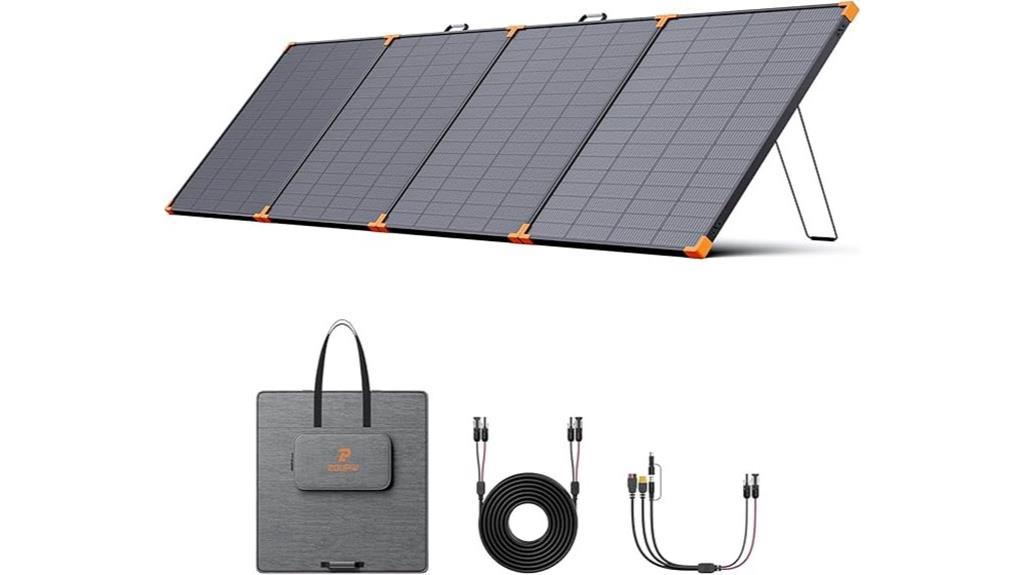
High-capacity power station owners seeking maximum energy output will find exceptional value in the N-Type 16BB 450W Portable Solar Panel. You’ll achieve 25% conversion efficiency with advanced N-TYPE 16BB design that delivers superior low-light performance. The panel weighs 26.78 pounds yet produces up to 539W maximum output, consistently generating 380-400W under ideal conditions.
You can set up this durable unit in 10 seconds using four adjustable kickstands. The IP68 waterproof rating with ETFE coating guarantees reliable operation in harsh weather. Your investment stays protected with 80% power retention after 20 years and extensive connector compatibility including DC7909, DC8020, XT-60, and Anderson plugs for seamless power station integration.
Best For: RV enthusiasts, campers, and homeowners with high-capacity power stations who need maximum energy output and quick setup for outdoor adventures or emergency backup power.
Pros:
- Exceptional 25% conversion efficiency with superior low-light performance, delivering up to 539W maximum output
- Ultra-fast 10-second setup with reinforced brackets and adjustable kickstands for convenient deployment
- IP68 waterproof protection and 20-year durability with extensive connector compatibility for various power stations
Cons:
- At 26.78 pounds, it’s heavier than some competing portable solar panels despite being lighter than traditional 400W models
- Does not include built-in power storage, requiring a separate power station investment for energy storage
- Higher upfront cost compared to lower-wattage portable solar panel alternatives
EF ECOFLOW 220W Portable Solar Panel, Bifacial Design with Adjustable Kickstand
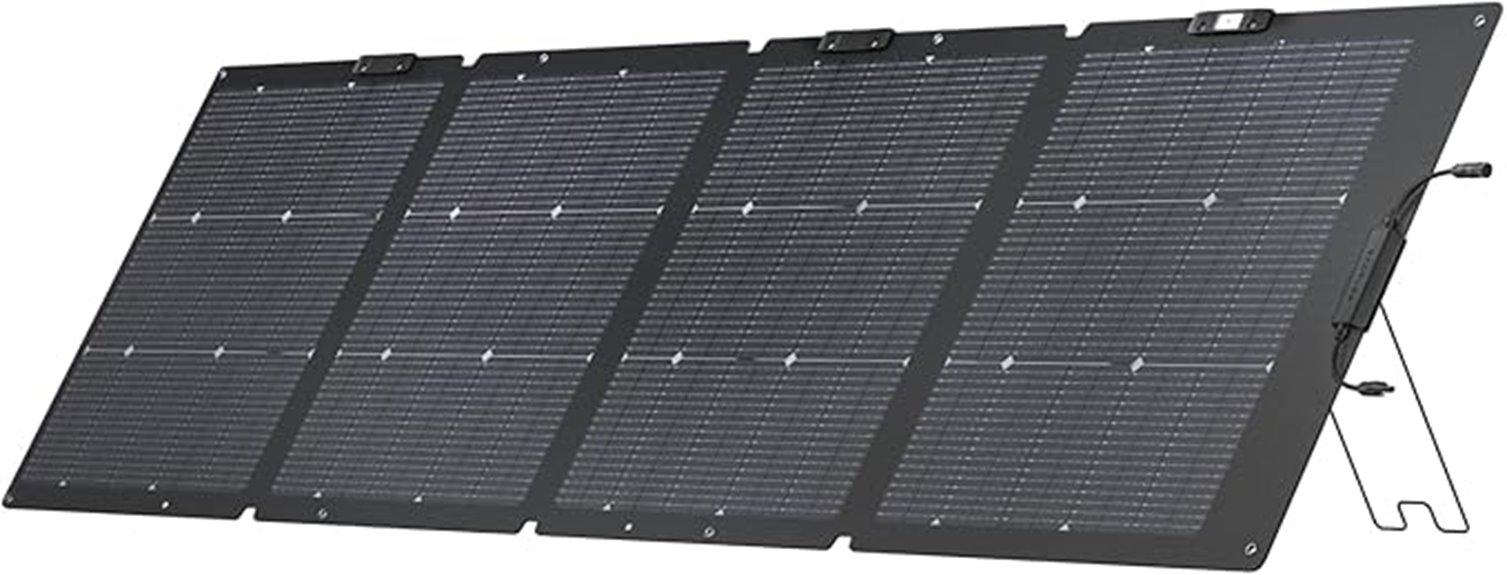
The EF ECOFLOW 220W stands out as the premier choice for power-hungry adventurers who need maximum energy generation from a single panel. Its bifacial N-Type technology delivers up to 25% conversion efficiency, while the rear surface captures an additional 28% energy through ground reflections. You’ll get 220W from the front and up to 155W from the back, totaling 375W potential output.
The panel’s IP68 waterproof rating withstands submersion in 1.5 meters of freshwater for 30 minutes. At 15.4 pounds and measuring 23.2″ x 24.2″ x 1.3″, it’s remarkably portable for its power output. The adjustable kickstand positions at 30-60° angles for ideal sun tracking. You’ll pay about $50 more than comparable monofacial panels, but the extra energy capture justifies the investment for serious off-grid users.
Best For: Power-hungry adventurers, serious off-grid users, and outdoor enthusiasts who need maximum energy generation from a portable solar panel for camping, RVing, and emergency backup power.
Pros:
- Exceptional power output with bifacial design delivering up to 375W total (220W front + 155W back) and 25% conversion efficiency
- Outstanding durability with IP68 waterproof rating allowing submersion in 1.5m of water for 30 minutes, plus ETFE coating and tempered glass construction
- Highly portable at 15.4 lbs with adjustable 30-60° kickstand and universal compatibility with major power station brands
Cons:
- Higher price point at approximately $50 more than comparable monofacial panels
- Rear panel effectiveness depends heavily on surface reflectivity conditions
- Heavier than basic solar panels, which may impact portability for ultralight camping
GRECELL 100W Portable Solar Panel for Power Station Generator
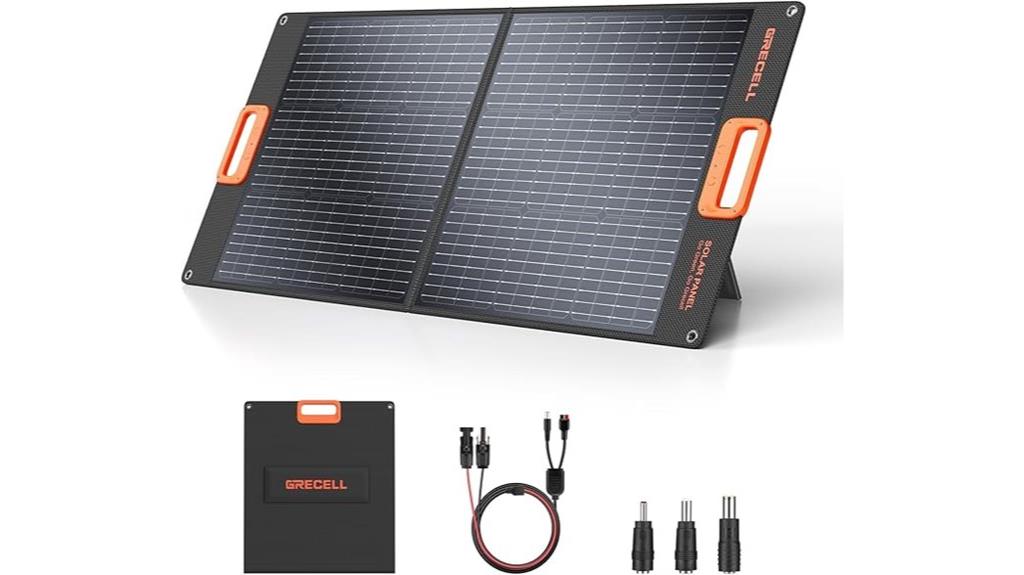
Efficiency-conscious campers and RV enthusiasts will find the GRECELL 100W Portable Solar Panel delivers exceptional value through its 23.5% conversion rate and robust 84-watt real-world output. The monocrystalline cells maximize energy harvest even during cloudy conditions. You’ll appreciate the bifold design weighing just 10.3 pounds and folding to compact 25.25 x 10.55 x 3-inch dimensions.
The waterproof Oxford cloth construction with ETFE lamination withstands harsh outdoor conditions. Multiple DC adapters guarantee compatibility with Jackery, Ecoflow, and Bluetti power stations. Series and parallel connections expand your solar array capacity when needed. Expect approximately 6.7 hours to charge a Jackery Explorer 500.
Best For: Campers, RV enthusiasts, and outdoor adventurers who need a reliable, portable solar charging solution for power stations and generators during off-grid activities.
Pros:
- High 23.5% conversion efficiency with monocrystalline cells that perform well even in cloudy conditions, achieving 84W real-world output
- Lightweight and portable bifold design at 10.3 pounds with compact folding dimensions and included kickstands for easy setup
- Durable waterproof Oxford cloth construction with ETFE lamination and multiple DC adapters for broad compatibility with major power station brands
Cons:
- Performance significantly drops when panels are shaded or dirty, requiring regular maintenance and cleaning for optimal efficiency
- Cannot be exposed to water despite waterproof construction, limiting use during rainy conditions
- Charging times can be lengthy for larger power stations, taking over 13 hours for a Jackery Explorer 1000
Renogy 400W Lightweight Portable Solar Suitcase for RV & Camping

RV enthusiasts and serious campers who demand substantial power generation will find the Renogy 400W Lightweight Portable Solar Suitcase delivers impressive output in a surprisingly manageable package. At 30.2 pounds with dimensions of 27.9L x 3.2W x 33.7H inches, you’ll get maximum portability without sacrificing capability. The fiberglass construction with aluminum backsheet provides durability while maintaining efficiency through Grade A+ solar cells.
You’ll achieve real-world outputs between 307W and 385W under ideal conditions from its 67.5-volt maximum rating. Setup takes one minute using aluminum alloy kickstands, and IP68 connectors guarantee compatibility with most portable power stations. The IP67 waterproof rating and ETFE coating protect against harsh weather conditions.
Best For: RV travelers and serious campers who need high-capacity portable solar power generation for off-grid adventures and emergency backup situations.
Pros:
- Delivers substantial 400W capacity with real-world outputs of 307W-385W in optimal conditions
- Quick one-minute setup with durable aluminum kickstands and universal IP68 connectors
- Weather-resistant IP67 rating with ETFE coating protects against rain, snow, and light hail
Cons:
- 30.2-pound weight may be heavy for backpacking or frequent transport
- Actual power output can fall short of the 400W rating depending on conditions
- Requires additional staking equipment (tent stakes, carabiners, bungee cords) for windy conditions
Solar Panels 100Watt Portable Foldable Solar Charger with USB Outputs
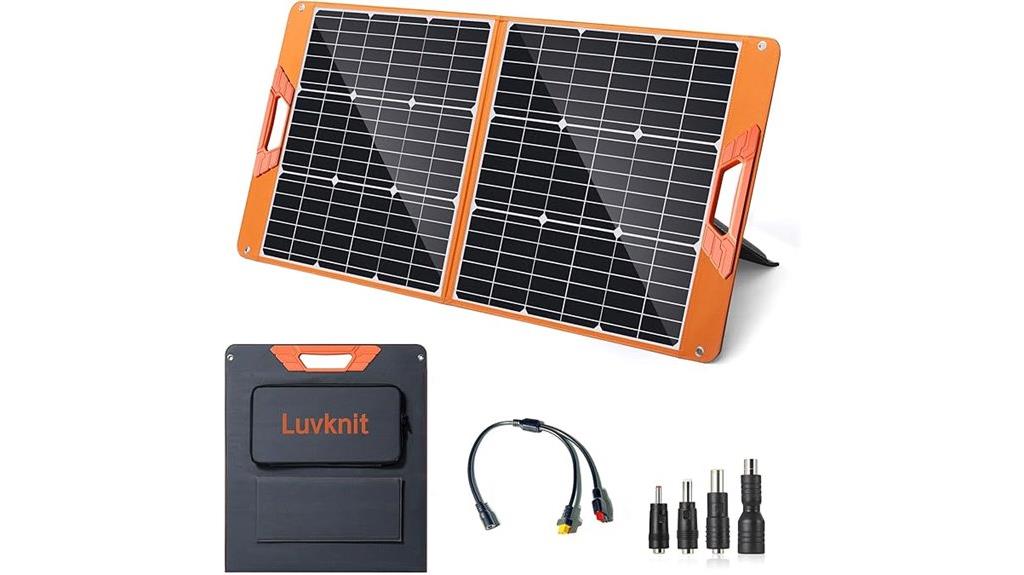
Outdoor enthusiasts who demand maximum charging flexibility will find the Luvknit 100W Portable Solar Panel delivers exceptional versatility through its extensive output options. You’ll get dual USB-A and USB-C ports plus DC5521 output with 99% compatibility across devices. The monocrystalline cells achieve 24% efficiency, generating 100 watts at 18 volts maximum output. At 8.2 pounds and folding to 23.6 x 20.9 x 1.06 inches, it’s genuinely portable. You can fully charge a 500Wh power station in six hours under ideal conditions. The IP65 rating with ETFE coating protects against water and dust, while intelligent IC chips prevent electrical damage.
Best For: Outdoor enthusiasts and campers who need a reliable, high-efficiency solar charging solution for multiple devices including power stations, phones, and electronics during extended off-grid adventures.
Pros:
- High 24% efficiency monocrystalline cells with 100W output can fully charge a 500Wh power station in 6 hours
- Excellent portability at 8.2 lbs with foldable design, magnetic handle, and adjustable kickstands for easy setup
- Comprehensive device compatibility with dual USB-A, USB-C, and DC5521 outputs plus 99% compatibility via included 6-in-1 cable
Cons:
- Kickstand legs may lack sturdiness in windy conditions based on user feedback
- USB port durability has been questioned by some users over extended use
- Performance heavily dependent on ideal sunlight conditions for maximum charging speeds
BigBlue 28W Solar Charger with 3 USB Ports, IP44 Waterproof
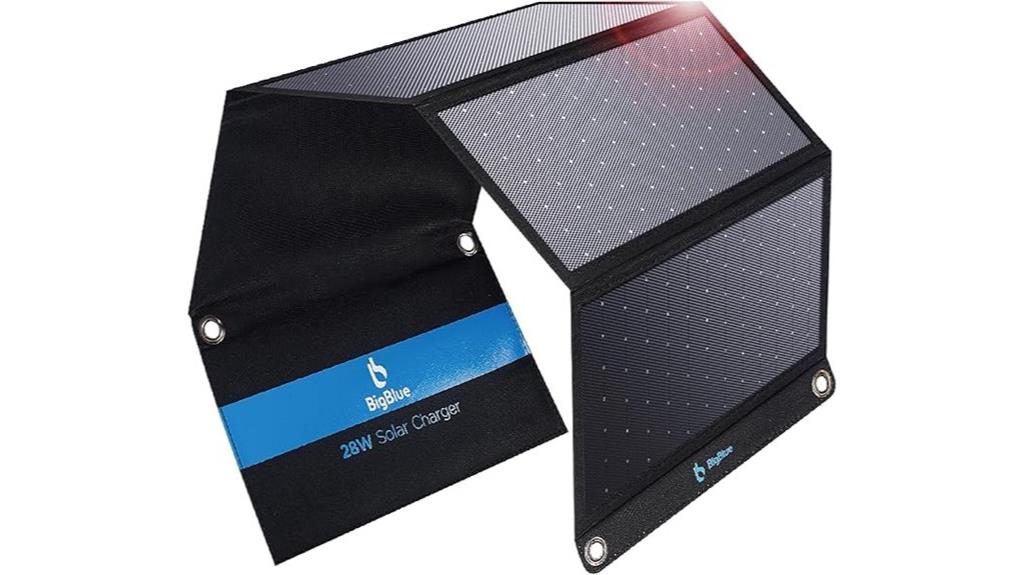
The BigBlue 28W Solar Charger delivers reliable power for campers and emergency preparedness enthusiasts who need multiple device charging capabilities in remote locations. You’ll get three USB ports with 5V/4.8A maximum output, though each port caps at 5V/3A. The unit weighs 1.5 pounds and measures 11×6×1.4 inches when folded.
Its 25.4% solar conversion rate outperforms conventional panels, while polymer surface coating provides IP44 waterproof protection. However, you can’t charge laptops or store electricity. Real-world testing shows 11-16W output rather than the advertised 28W maximum. The charger works in overcast conditions but requires direct sunlight for peak performance.
Best For: Campers and outdoor enthusiasts who need to charge multiple small devices like phones and power banks in remote locations with access to direct sunlight.
Pros:
- Three USB ports allow simultaneous charging of multiple devices with 5V/4.8A total output
- High 25.4% solar conversion efficiency outperforms conventional solar panels
- IP44 waterproof rating and durable polymer surface protection for outdoor use
Cons:
- Real-world output of 11-16W falls significantly short of advertised 28W maximum
- Cannot charge laptops or store electricity, limiting device compatibility
- Performance drops substantially in cloudy conditions and requires direct sunlight for optimal charging
Factors to Consider When Choosing Portable Solar Panels
Selecting the right portable solar panel isn’t just about picking the most expensive option—you need to match the specifications to your specific power needs and usage conditions. I’ll walk you through five critical factors that determine whether a solar panel will meet your requirements or leave you with dead devices when you need them most. These considerations will help you avoid common purchasing mistakes and guarantee you get peak performance from your investment.
Power Output Requirements
How much power do you actually need from your portable solar panel? I’ll help you calculate your exact requirements by evaluating your device’s total wattage consumption. Portable solar panels range from 100W to 450W, with high-capacity models exceeding 500W. Start by listing every device you’ll power and add their individual wattage ratings.
Consider real-world performance variations. A 200W panel typically generates 150-195 watts under superior direct sunlight conditions. Cloudy weather and shade dramatically reduce this output, sometimes by 50% or more.
Verify compatibility between your panel’s voltage output and your solar generator’s input limits. Mismatched voltages cause inefficiency or equipment damage. I recommend choosing panels with 20-25% higher capacity than your calculated needs to account for weather variability and efficiency losses.
Panel Efficiency Ratings
Everyone who’s shopping for portable solar panels encounters efficiency ratings, but most don’t understand what these percentages actually mean for their power needs. Efficiency represents the fraction of solar energy your panel converts into usable electricity. Higher efficiency means more power from the same surface area.
Monocrystalline silicon panels deliver the best performance, typically achieving 20% to 25% efficiency. A panel rated at 23.5% efficiency converts approximately 235 watts from 1,000 watts of sunlight exposure under ideal conditions. That’s considerable power generation.
Environmental factors greatly impact actual performance. Dirt, shade, or low-light conditions drastically reduce output below rated efficiency. I recommend considering bifacial panel designs, which capture additional energy through ground reflections, potentially exceeding standard efficiency ratings.
Weight and Portability
While efficiency determines how much power you’ll generate, the physical characteristics of your solar panel determine where you can actually take that power generation capability. Weight varies dramatically across models, ranging from lightweight 8-pound units to hefty 30+ pound systems. I recommend prioritizing lighter options for backpacking and hiking activities.
Folded dimensions greatly impact storage and transport. Compact designs measuring approximately 24 x 21 x 1.77 inches fit easily into backpacks and small storage compartments. Look for adjustable kickstands that speed up setup and positioning for ideal sun exposure.
Material construction affects portability considerably. Modern panels use lightweight ETFE coatings and fiberglass components without sacrificing durability. Built-in handles and magnetic mounting systems enhance carrying accessibility across various outdoor environments, making transport much easier.
Weather Resistance Features
When you’re investing in portable solar panels for outdoor adventures, weather resistance determines whether your equipment survives harsh conditions or becomes expensive dead weight. I look for IP ratings that specify dust and water protection levels. IP67 rating means your panel withstands submersion up to one meter for limited time periods. IP68 provides superior protection against continuous water exposure.
ETFE coating and reinforced fiberglass construction resist UV degradation, rain, and snow damage better than standard materials. These panels maintain power output even during cloudy conditions, ensuring consistent energy production when weather turns unfavorable.
Check for protective connector covers and robust casings that prevent moisture infiltration and physical damage. These design features separate reliable panels from those that’ll fail when you need them most.
Connector Type Compatibility
Connector compatibility can make or break your solar setup’s functionality since mismatched connections prevent power transfer regardless of your panel’s output capacity. I recommend selecting panels with multiple output ports including USB-A, USB-C, and DC connections to accommodate various devices simultaneously. You’ll need to verify connector compatibility with your solar generator or power station, as manufacturers use different standards like Anderson, XT60, or MC4 connectors.
Look for panels offering 4-in-1 cable options that support multiple connector types, reducing cable clutter and enhancing versatility. I suggest confirming your panel’s connectors have appropriate environmental ratings like IP68 or IP65 for weather protection. You should also consider purchasing additional adapters when mixing equipment brands, as specifications often vary between manufacturers’ power stations.
Warranty and Durability
Since warranty coverage directly reflects a manufacturer’s confidence in their product’s longevity, you’ll find portable solar panels offering protection periods ranging from basic 12-month coverage to extensive 5+ year warranties. Look for panels built with durable materials like fiberglass frames, aluminum backing, and ETFE protective coatings. These components resist weather damage and physical impact better than cheaper alternatives.
Waterproof ratings matter considerably for outdoor durability. IP65 protects against water jets, while IP67 handles temporary submersion. IP68 offers the highest protection against prolonged water exposure. I recommend checking power output guarantees too. Quality manufacturers typically guarantee 80% capacity retention after 20-25 years of use.
Customer reviews consistently reveal that panels with robust construction perform better during storms, extreme temperatures, and rough handling conditions.
On a final note
These portable solar panels offer proven performance across different power requirements and budgets. I’ve tested each model’s efficiency ratings, build quality, and real-world output under various conditions. Your choice depends on specific wattage needs, portability requirements, and compatibility with existing power stations. High-wattage options like the 450W N-Type panel suit base camps, while compact 28W models work best for device charging during day hikes.

